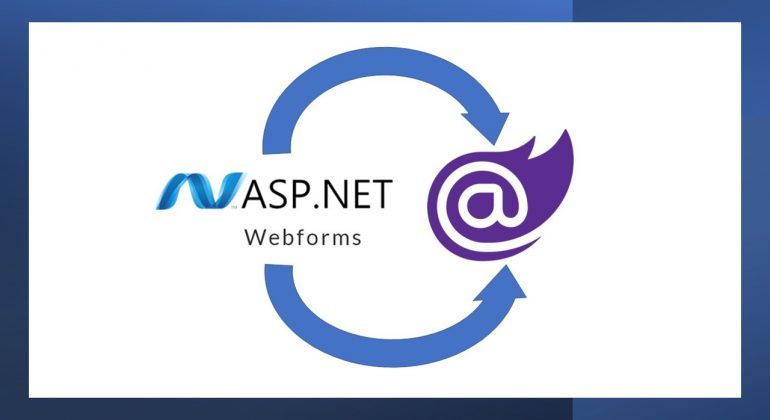Migrating Legacy ASP.NET Web Forms to Blazor: Key Aspects to Consider
Migrating a legacy ASP.NET Web Forms application to Blazor can bring many benefits, including improved performance and a more modern development experience. However, it’s important to understand the necessary steps and potential challenges involved in such a migration.
One of the key differences between ASP.NET Web Forms and Blazor is the programming model. In ASP.NET Web Forms, server-side code and postbacks are used to update the user interface. In contrast, Blazor uses a client-side, component-based model to handle UI updates. The following code example illustrates the difference in how a button click event is handled in both frameworks.
ASP.NET Web Forms:
<asp:Button ID="Button1" runat="server" Text="Button" OnClick="Button1_Click" />
protected void Button1_Click(object sender, EventArgs e)
{
// Server-side code to handle button click event
}
Blazor:
<button @onclick="ButtonClick">Button</button>
@code {
private void ButtonClick()
{
// Client-side code to handle button click event
}
}
Another important aspect of migration is the handling of existing data and business logic. In most cases, this logic will need to be rewritten to work with the new Blazor framework. This can be a time-consuming process, and it’s important to have a clear plan for how to handle this task.
Additionally, the migration process can be complex due to the need to update the application’s architecture, data access, and UI components. This can also be time-consuming and require significant effort.
However, the benefits of migrating to Blazor can be significant. Blazor provides a modern, client-side development experience that can improve application performance and responsiveness. It also allows developers to use C# and the familiar ASP.NET ecosystem to build web applications, rather than relying on JavaScript.
However, there are a number of situations in which JavaScript is still needed. The Blazor comes with JavaScript interop feature to handle such scenarios. Using JavaScript interop, developers can easily integrate existing JavaScript libraries and frameworks into their Blazor application. For example, a developer can use a JavaScript library for charts and graphs, and then use JavaScript interop to display the chart in a Blazor component. This can be a powerful tool for migrating a legacy application, as it allows developers to take advantage of existing JavaScript code and libraries.
Following are some of the reasons why JavaScript interop is needed when migrating a legacy ASP.NET Web Forms application to Blazor.
- Accessing browser APIs: Certain browser APIs, such as the
navigatorandlocationobjects, are not yet available in WebAssembly. In order to access these APIs, developers will need to use JavaScript interop. - Using existing JavaScript libraries and frameworks: Many legacy applications may rely on existing JavaScript libraries and frameworks for certain functionality, such as charts and graphs, or form validation. JavaScript interop allows developers to continue using these libraries and frameworks in their Blazor application.
- Handling browser events: Some browser events, such as
window.onbeforeunloadandwindow.onpopstate, may not be directly handled by Blazor. Developers may need to use JavaScript interop to handle these events. - Accessing the DOM: Blazor’s component model abstracts away the underlying DOM, but in some cases, developers may need to access the DOM directly. JavaScript interop can be used to do this.
- Handling third-party libraries or APIs: Third-party libraries or APIs that are not available in C# can be accessed via JavaScript interop.
It’s important to note that while JavaScript interop can be a powerful tool for migrating a legacy application, it should be used carefully and sparingly. Overuse of JavaScript interop can increase the complexity of the application and make it harder to test and maintain. It’s always recommended to prioritize the use of the built-in features and capabilities of the framework before resorting to JavaScript interop.
Here are some key aspects to consider for migration
- Programming model: Blazor uses a client-side, component-based model, which is different from the traditional server-side, postback model of ASP.NET Web Forms. Developers will need to learn new concepts and techniques for building client-side logic and handling UI updates.
- Handling existing data and business logic: The migration process will likely involve rewriting existing data access and business logic to work with the new Blazor framework. This can be a time-consuming process, and it’s important to have a clear plan for how to handle this task.
- Update of application’s architecture: With the migration, the application’s architecture may need to be updated to take advantage of the features of the Blazor framework. This may include changes to data access, routing, and other key components of the application.
- Update of UI components: The migration will likely involve updating the UI components to use the new Blazor components and layout. This may also include changes to the application’s CSS and JavaScript.
- Testing and Quality assurance: The migration process will need to be thoroughly tested, including regression testing of the entire application, and Quality assurance to ensure that the application behaves as expected.
- Performance tuning: With the migration, the performance of the application may need to be optimized, especially if there are large amounts of data to be handled.
- Deployment and maintenance: The migration process will need to be deployed in a way that allows for minimal downtime, and it will require ongoing maintenance to ensure that the application continues to function correctly.
- Training: Developers, Support team, and other stakeholders will need to be trained on the new Blazor framework and its features to ensure that they can effectively maintain and enhance the application.
In summary, migrating a legacy ASP.NET Web Forms application to Blazor can bring many benefits, but it’s important to understand the necessary steps and potential challenges involved. This includes the need to learn new concepts and techniques, handle existing data and business logic, and update the application’s architecture. With a clear plan, the migration process can be managed effectively, and the benefits of Blazor can be realized.


